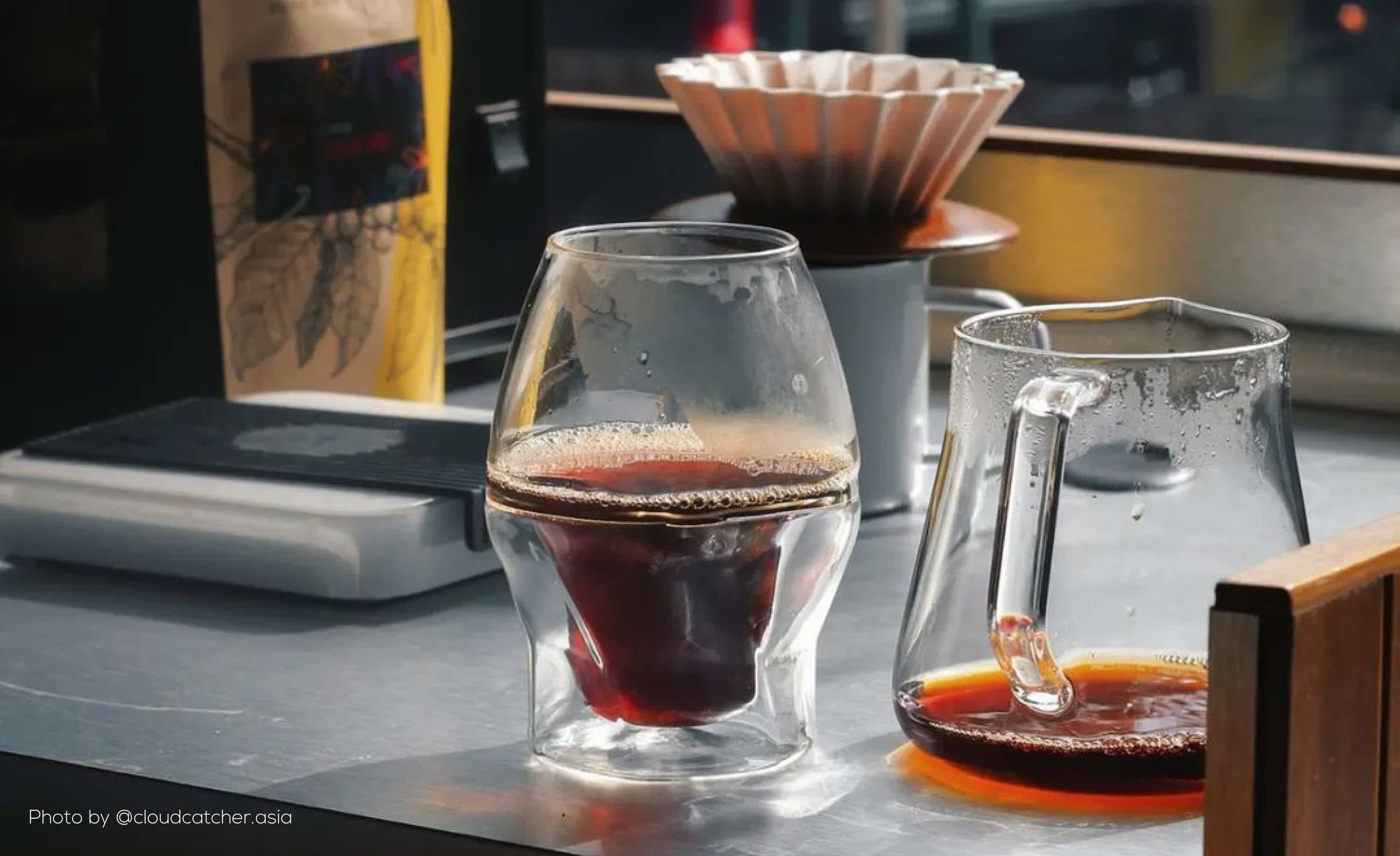
Much like wine, coffee also comes from fresh produce often called coffee cherries or coffee fruit. Like me when I first started on my coffee journey, you might be surprised to learn that the seeds of these cherries are what then become the coffee beans that you buy (and eventually get turned into that delicious coffee bean juice you love 😉) . But in between harvesting these fruits and the beans that you brew, there’s an intricate method of processing the seeds that directly affects how your coffee will taste.
3 Main Types of Coffee Processing Methods

Infographic from Bean & Bean Coffee Roasters Co.
So what does ‘coffee processing’ even mean?
Coffee processing simply refers to the method of removing or pulling the seed from the coffee cherry. It may sound simple, but differences in the way it’s removed greatly affects the seed’s flavor, therefore affecting the final brew’s taste.
The same as with the subtle nuances within a coffee’s terroir, even the most subtle changes in the method that the seeds are removed plays a big part in the body, acidity, and sweetness of your coffee. The same coffee from the same plot of land can be processed in different ways, resulting in completely different tasting experiences from the same bean! As coffee research continues to evolve and develop, processing methods are becoming more complex and producers are able to apply different processing methods to bring out the best flavors from their coffee. This is why it’s worth knowing the 3 main types of coffee processing methods and how your favorite flavors came to be.
1. Washed Coffee (Wet Processed)

Infographic from Bean & Bean Coffee Roasters Co.
Ever wondered what process is behind your favorite single origin coffees? Washed process (also known as ‘wet processing’) is the main method behind single origin coffees. This method relies solely on the bean after it’s been removed from the fruit completely.

Image from Café de Colombia
The whole process involves using machines called “depulpers” to remove the seeds from the cherries. These seeds then go into tanks filled with water, which then thoroughly ‘washes’ the rest of the pulp and fruit remains from the seeds before they’re placed on drying beds under the sun. The whole process is the fastest and most efficient way of processing coffee, however, it’s also the method that brings about the most waste.
Ask any coffee enthusiast and they would most likely tell you that this is the coffee processing method they prefer. It’s mainly because the resulting flavor depends solely on the sugars and nutrients that the bean absorbed during its cultivation. This is where the true distinction of terroirs and the science behind growing coffee can be recognized. If you prefer consistently clean and crisp-tasting coffee — or if you simply prefer single origin coffees — then you should know that this is the process behind it all.
ICOSA Brewhouse Recommendations:
2. Natural Processed Coffee (Dry Processed)

Infographic from Bean & Bean Coffee Roasters Co.
On the other side of the spectrum, we have natural processed coffee, which is also known as ‘dry processed’. This is a traditional method originating in Ethiopia, which starts off with drying the entire cherry fruit under the sun. The fruit will then ferment for about 3 to 6 weeks, as farmers continue to manually rotate and rake them to prevent spoiling. Seeing natural processed coffee tends to be more rare compared to washed coffees for the very reason that natural coffees are quite labor intensive, but there’s a reason why coffee enthusiasts swear by this method for getting the most flavor from their coffee.
It’s through this fermentation period where the sugars and mucilage attach to the seeds, creating a sweeter flavor compared to wet processed seeds. Once the seeds dry from fermentation, they are then placed in a depulper to separate the seeds from the fruits.

Image from Atlas Coffee
If you enjoy a sweeter blend of flavors from your coffee, then choosing beans that are naturally processed is the way to go. These beans are known to have fruity, sugary flavors that cater to a certain kind of coffee connoisseur. It’s well worth noting, however, that this process is recognized as having more inconsistencies given the fermentation process and the way the flavors of the fruit attach to the seed itself. That said, some coffee lovers tend to shy away from dry processed beans because they do feel that the intrinsic flavor of the bean can get masked by its derived sweetness. If you’re open to a sensory adventure, you should definitely look for a natural processed coffee on your next trip to your neighborhood roastery!
ICOSA Brewhouse Recommendations:
3. Honey Processed Coffee

Infographic from Bean & Bean Coffee Roasters Co.
Ever wonder if you can combine wet and dry coffee processing? Honey processed coffee combines the best of both worlds, but it’s done more infrequently than the two. This is because honey processed coffee requires more effort, but when done right the beans can end up tasting as though you’ve added honey in your brew.
This process starts off with depulping the cherries, removing the outer skin but leaving the mucilage on the seed. And just so we’re clear, the term “honey” is actually derived from the mucilage left on the seed (i.e. is the sweet, sticky substance covering the seed). After depulping, the seeds are then placed on drying beds before they undergo the same fermentation process in natural/dry coffee processing. The last stage of this process is known as “hulling,” where the seeds are placed in a machine that removes dried mucilage and that flaky parchment that covers the seed.

Image from Coffee Craft Code
Just by knowing the process, you can probably guess the resulting flavor. It is, of course, sweeter than wet processed coffee but not as sugary sweet as dry processed beans. This method is widely practiced in Costa Rica more than any other coffee-producing region and is regarded as the best method, giving coffee lovers a taste of both the intrinsic flavors of the bean with some complex fruity notes. Given its rarity, you should definitely pick up a bag of honey processed coffee the next time you spot it at a roastery, you just might fall in love!
3 New Types of Groundbreaking Coffee Processes
Thanks to the growing demand for specialty coffee around the world, coffee professionals have started exploring modern methods of coffee processing with the goal of pushing the boundaries of flavor.
These three new types of coffee processing methods focus mostly on the fermentation part and are, for the most part, still being studied and experimented in different coffee regions. That said, it’s still definitely worth getting an insight into these groundbreaking coffee fermentation methods and how it contributes to enhancing the quality, flavor, and aroma of specialty coffee.
1. Carbonic Maceration

Image from Sabores.co.za
Borrowing from the winemaking industry, carbonic maceration was introduced in 2015 when barista champion Saša Šestić used this method for his World Brewers Cup winning coffee. Carbonic maceration (fermentation) mainly involves placing freshly harvested cherries in airtight barrels, which are then injected with carbon dioxide.
In this process, all aromatics and flavors produced during the fermentation process are fully absorbed by the fruit as it has no way to escape the container. This contributes to a ‘stoned fruit’ quality of your coffee. One thing to note with this process is that it can take months to get the right flavor because it’s fermenting the whole fruit and not just the seed. After achieving the desired level of fermentation, the fruits are then processed by either washing or drying.
It’s safe to say that carbonic maceration became an overnight sensation within the industry since it was popularized by Šestić in 2015. While some may argue that this is still being experimented upon by coffee farms, it can’t be denied that using this process has become a unique selling point for specialty coffee producers. So if you’re looking for a fresh take on specialty coffee, look into those that undergo carbonic maceration to get a taste of that bright and winey coffee with strong notes of red (berry) fruits.
ICOSA Brewhouse Recommendations:
2. Anaerobic Fermentation

Image from mtpak.coffee
If carbonic maceration is about creating a CO2-abundant environment for the cherries, anaerobic fermentation is about restricting oxygen. The pulp and other parts of the cherry that were gathered separately are left to ferment inside sealed, airtight tanks for about 12 to 100 hours — mostly depending on the producer’s judgment call.
Anaerobic fermentation is gaining popularity in coffee regions within Central America like Costa Rica and Honduras. The main rationale behind this process is to let the seed absorb the substances from the juice and pulp. This approach gives you a rather creamy texture, some acidity, and possible notes of cinnamon and flowers.
3. Lactic Fermentation

Image from Collaborative Coffee Source
Recognized as the flagship process of the La Palma y El Tucan plantation in Colombia, Lactic Fermentation or Lactic Process also involves restricting oxygen during fermentation. The main difference with anaerobic fermentation is that this process is done with lactic acid bacteria cultures. It’s important to take note of the pH measurement, oxygen level, and sugar content as the cherries ferment. Once the optimal pH level is reached, the cherries are then soaked in clean water to stop the growth of bacteria and then are dried under the sun.
Lactic fermentation is still very much at the experimental stage but if you’re looking to get a taste of coffee beans that are processed this way, do expect some “wild” fruity notes with a more pronounced acidity, aroma, and flavor.
When we talk about coffee beans, the method in which it was processed does tend to get overlooked as we focus more on the terroir and the type of roast. While coffee processing can be such a technical thing to discuss, we can’t deny the role it plays in the resulting flavors of our brew. Knowing these methods definitely adds another layer to what true coffee appreciation means, but all these layers of complexity are what make coffee the delicious adventure that it is!
And one more tip from us, if you can’t seem to find the process that was involved in the coffee you want to try, simply send the roaster a message via social media or their email!

Say hello to your new coffee e-zine for the most interesting news, tips, and trends in the world of coffee.



